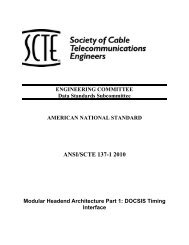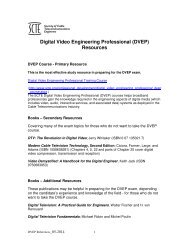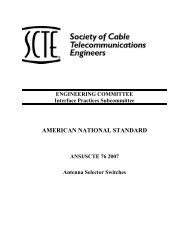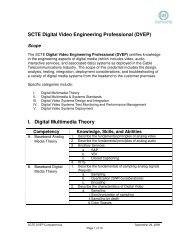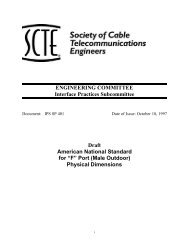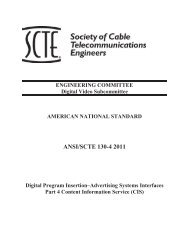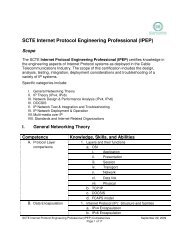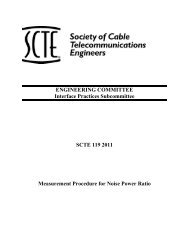ANSI/SCTE 16 2001R2007
ANSI/SCTE 16 2001R2007
ANSI/SCTE 16 2001R2007
You also want an ePaper? Increase the reach of your titles
YUMPU automatically turns print PDFs into web optimized ePapers that Google loves.
Appendix 4 – Time domain vs. Frequency domain Measurements<br />
This appendix is intended to demonstrate a mathematical correlation between the time<br />
domain measurement method (which this procedure details), and the frequency domain<br />
measurement method. The frequency domain method uses a spectrum analyzer as a tuned<br />
receiver to demodulate the 60, 120, or 180 Hz hum sidebands to baseband for measurement with<br />
a low frequency spectrum analyzer. This measurement technique is seldom used as it requires a<br />
spectrum analyzer with 10Hz or better resolution.<br />
Before a correlation between the two measurement methods is shown, the equations for<br />
conventional AM and TV AM should be reviewed.<br />
Conventional AM:<br />
x(t)<br />
= A 1<br />
[ + m( cosω m t)<br />
] cosω<br />
t<br />
(A -14)<br />
Where A is the carrier and m is the conventional modulation index. The equation for TV AM<br />
(A-1) is located in Appendix 1. If these equations are converted to show the AM sidebands:<br />
Conventional AM:<br />
⎡<br />
x( t)<br />
= A<br />
⎢<br />
cosω<br />
⎣<br />
c<br />
t +<br />
1<br />
2<br />
c<br />
[ ( ω − ω ) t + cos( ω + ω ) t] (A -15)<br />
m cos<br />
c<br />
m<br />
c<br />
m<br />
⎥ ⎦<br />
⎤<br />
TV AM:<br />
⎡<br />
y(t)<br />
= B<br />
⎢<br />
1−<br />
⎣<br />
k<br />
4<br />
[ ( k / 2)<br />
] cosω<br />
t − [ cos( ω − ω ) t + cos( ω + ω ) t] (A -<strong>16</strong>)<br />
c<br />
c<br />
m<br />
It can be determined from these equations that for conventional AM signals, the AM sidebands<br />
are m/2 volts(assuming that carrier A is 1 volt). For TV AM, the sidebands are k/4 volts(also<br />
assuming that carrier B is 1 volt). Appendix 1, through mathematical derivation, shows that<br />
Hum(dB) = 20Log(k). If the frequency domain method is used to measure the sideband, the<br />
equation becomes:<br />
Hum(dB)<br />
= 20Log<br />
Therefore, for frequency domain measurements, a correction factor of 12 dB must be subtracted<br />
from the measurement to correlate to the time domain measurement method.<br />
c<br />
( k ) = 20Log(k) − 20Log4 = 20log(k) −12<br />
(A -17)<br />
4<br />
m<br />
⎥ ⎦<br />
⎤<br />
15



